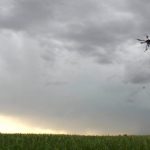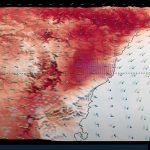 July 19, 2021 4:05 pm
Published by Climate Extremes
July 19, 2021 4:05 pm
Published by Climate Extremes
CLEX researchers and colleagues combined high-resolution regional climate projections with a process-based hazelnut simulation model to predict future hazelnut yield in Australia.
 July 19, 2021 1:36 pm
Published by Jenny Rislund
July 19, 2021 1:36 pm
Published by Jenny Rislund
The passage of weather fronts over southeast Australia during the spring and summer increases the risk of dangerous fire weather. This project will carry out an analysis of observational data to determine a method for characterising when fronts have passed through southeast Australia.
 July 16, 2021 10:12 am
Published by Climate Extremes
July 16, 2021 10:12 am
Published by Climate Extremes
The overarching goal of the Colorado State University Convective CLoud Outflows and UpDrafts Experiment (C3LOUD-Ex) was to enhance our understanding of deep convective storm processes and how they are represented in numerical models. Pivotal to the experiment was a novel “Flying Curtain” strategy.
 July 14, 2021 2:23 pm
Published by Climate Extremes
July 14, 2021 2:23 pm
Published by Climate Extremes
This study looks at 6 months of under-ice zooplankton observations from the N-ICE2015 expedition from January to June 2015 in the Eurasian sector of the Arctic Ocean north of Svalbard.
 July 14, 2021 1:46 pm
Published by Climate Extremes
July 14, 2021 1:46 pm
Published by Climate Extremes
This research uses Sydney, Australia’s largest city, as a test case for our new configuration of the Weather and Research Forecasting model run at a very high resolution of 800 m with a new urban classification scheme that describes the complexity of Sydney’s built environment.
 July 14, 2021 1:23 pm
Published by Climate Extremes
July 14, 2021 1:23 pm
Published by Climate Extremes
In this study, CLEX researchers and colleagues showed that the North Atlantic sea-surface temperature response to ENSO is nonlinear with respect to the strength of the sea-surface temperature forcing in the tropical Pacific.
 July 13, 2021 2:59 pm
Published by Climate Extremes
July 13, 2021 2:59 pm
Published by Climate Extremes
CLEX researchers used data from a wind profiler radar pair at Darwin, Australia, to determine the characteristics of individual up- and downdrafts observed at the site. They found updrafts with 5km vertical heights with extreme rain rates.
 June 23, 2021 10:41 am
Published by Climate Extremes
June 23, 2021 10:41 am
Published by Climate Extremes
Climate sensitivity describes how sensitive the Earth’s temperature is to a doubling of the amount of carbon dioxide in the atmosphere. One measure of climate sensitivity for projections of future climate is the Equilibrium Climate Sensitivity (ECS). ECS is the increase in the global average temperature between the pre-industrial era and a future doubled carbon dioxide climate once equilibrium of the climate has been reached.
 June 17, 2021 8:55 am
Published by Climate Extremes
June 17, 2021 8:55 am
Published by Climate Extremes
Navid Constantinou developed a new Julia package that provides solvers for geophysical fluid dynamics problems in periodic domains. It was also the first time he had been involved in an open peer-review process, and this experience was "mind changing".
 June 17, 2021 8:31 am
Published by Climate Extremes
June 17, 2021 8:31 am
Published by Climate Extremes
CLEX researcher Navid Constantinou and collaborators developed GeophysicalFlows.jl, a Julia package that provides solvers for geophysical fluid dynamics problems in periodic domains.










